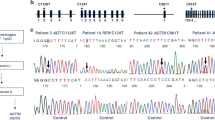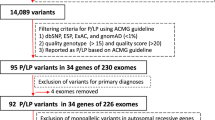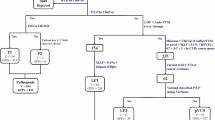Abstract
Previous studies have suggested that angiotensinogen (AGT) gene variants are associated with increased plasma AGT levels, and may also contribute towards the inherited component of predisposition to essential hypertension in humans. To explore the potential functionality of several AGT polymorphisms and estimate their effects, together with other sources of familial correlations, on plasma AGT, we undertook a large study involving 545 healthy French volunteers in 130 nuclear families that include 285 offspring. Plasma AGT levels were measured in all participants, and bi-allelic AGT variants were analysed as candidate functional variants at three sites in the 5′-flanking region (C-532T, A-20C, G-6A), two sites in exon 2 (M235T, T174M) and two newly identified variant sites in the untranslated sequence of exon 5 and the 3′-flanking region (C+2054A, C+2127T) of the gene. Analysis with the class D regressive model showed significant effects influencing plasma AGT levels of all AGT polymorphisms tested, with the exception of T174M. The most significant result was found at C-532T (P=0.000001), which accounts for 4.3% of total plasma AGT variability in parents and 5.5% in offspring, with substantial residual familial correlations. Maximum likelihood estimates of haplotype frequencies and tests of linkage disequilibrium between each AGT polymorphism and a putative QTL are in agreement with a complete confounding of C-532T with the QTL, when taking into account sex and generation specific effects of the QTL. However, further combined segregation-linkage analyses showed significant evidence for additional effects of G-6A, M235T and C+2054A polymorphisms after accounting for C-532T, which supports a complex model with at least two functional variants within the AGT gene controlling AGT levels.
Similar content being viewed by others
Log in or create a free account to read this content
Gain free access to this article, as well as selected content from this journal and more on nature.com
or
References
Brasier AR, Li J . Mechanisms for inducible control of angiotensinogen gene transcription Hypertension 1996 27: 465–475
Jeunemaitre X, Soubrier F, Kotelevtsev YV et al. Molecular basis of human hypertension: role of angiotensinogen Cell 1992 71: 169–180
Hata A, Namikawa C, Sasaki M et al. Angiotensinogen as a risk factor for essential hypertension in Japan J Clin Invest 1994 93: 1285–1287
Iwai N, Shimoike H, Ohmichi N, Kinoshita M . Angiotensinogen gene and blood pressure in the Japanese population Hypertension 1995 25: 688–693
Johnson AG, Simons LA, Friedlander Y, Simons J, Davis DR, MaCallum J . M235–>T polymorphism of the angiotensinogen gene predicts hypertension in the elderly J Hypertens 1996 14: 1061–1065
Caulfield M, Lavender P, Farrall M et al. Linkage of the angiotensinogen gene to essential hypertension N Engl J Med 1994 330: 1629–1633
Rotimi C, Morrison L, Cooper R et al. Angiotensinogen gene in human hypertension. Lack of an association of the 235T allele among African Americans Hypertension 1994 24: 591–594
Fornage M, Turner ST, Sing CF, Boerwinkle E . Variation at the M235T locus of the angiotensinogen gene and essential hypertension: a population-based case-control study from Rochester, Minnesota Hum Genet 1995 96: 295–300
Hingorani AD, Sharma P, Jia H, Hopper R, Brown MJ . Blood pressure and the M235T polymorphism of the angiotensinogen gene Hypertension 1996 28: 907–911
Brand E, Chatelain N, Keavney B et al. Evaluation of the angiotensinogen locus in human essential hypertension: an European study Hypertension 1998 31: 725–729
Niu T, Xu X, Rogus J et al. Angiotensinogen gene and hypertension in Chinese J Clin Invest 1998 101: 188–194
Inoue I, Nakajima T, Williams CS et al. A nucleotide substitution in the promoter of human angiotensinogen is associated with essential hypertension and affects basal transcription in vitro J Clin Invest 1997 99: 1786–1797
Jeunemaitre X, Inoue I, Williams C et al. Haplotypes of angiotensinogen in essential hypertension Am J Hum Genet 1997 60: 1448–1460
Plouin PF, Chatellier G, Guyene TT, Vincent N, Corvol P . Recent advances in the clinical study of the renin system. Reference values and conditions of validity Presse Med 1989 18: 917–921
Marcadet A, O'Connell P, Cohen D . Standardized southern blot workshop technique in Dupont B (ed) Histocompatibility Testing New York: Springer 1986 vol 1: pp 553–560
Fukamizu A, Takahashi S, Seo MS et al. Structure and expression of the human angiotensinogen gene. Identification of a unique and highly active promoter J Biol Chem 1990 265: 7576–7582
Orita M, Suzuki Y, Sekiya T, Hayashi K . Rapid and sensitive detection of point mutations and DNA polymorphisms using the polymerase chain reaction Genomics 1989 5: 874–879
Sheffield VC, Beck JS, Kwitek AE, Sandstrom DW, Stone EM . The sensitivity of single-strand conformation polymorphism analysis for the detection of single base substitutions Genomics 1993 16: 325–332
Nibu Y, Takahashi S, Tanimoto K, Murakami K, Fukamizu A . Identification of cell type-dependent enhancer core element located in the 3′-downstream region of the human angiotensinogen gene J Biol Chem 1994 269: 28598–28605
Nibu Y, Tanimoto K, Takahashi S, Ono H, Murakami K, Fukamizu A . A cell type-dependent enhancer core element is located in exon 5 of the human angiotensinogen gene Biochem Biophys Res Commun 1994 205: 1102–1108
Liu Q, Sommer SS . Restriction endonuclease fingerprinting (REF): a sensitive method for screening mutations in long, contiguous segments of DNA Biotechniques 1995 18: 470–477
Sanger F, Nicklen S, Coulson AR . DNA sequencing with chain-terminating inhibitors Proc Natl Acad Sci USA 1977 74: 5463–5467
Saiki RK, Bugawan TL, Horn GT, Mullis KB, Erlich HA . Analysis of enzymatically amplified beta-globin and HLA-DQ alpha DNA with allele-specific oligonucleotide probes Nature 1986 324: 163–166
Lathrop GM, Lalouel JM, Julier C, Ott J . Strategies for multilocus linkage analysis in humans Proc Natl Acad Sci USA 1984 81: 3443–3446
Thompson EA, Deeb S, Walker D, Motulsky AG . The detection of linkage disequilibrium between closely linked markers: RFLPs at the AI-CIII apolipoprotein genes Am J Hum Genet 1988 42: 113–124
Bonney GE . On the statistical determination of major gene mechanisms in continuous human traits: regressive models Am J Med Genet 1984 18: 731–749
Demenais FM, Murigande C, Bonney GE . Search for faster methods of fitting the regressive models to quantitative traits Genet Epidemiol 1990 7: 319–334
Bonney GE, Lathrop GM, Lalouel JM . Combined linkage and segregation analysis using regressive models Am J Hum Genet 1988 43: 29–37
Demenais F, Lathrop M . REGRESS: a computer program including the regression approach into the linkage package Genet Epidemiol 1994 11: 291
Lalouel JM . GEMINI-a computer program for optimization of non-linear assumptions. Department of Medical Biophysics and Computing, University of Utah, Technical Report # 14, 1979
Boerwinkle E, Chakraborty R, Sing CF . The use of measured genotype information in the analysis of quantitative phenotypes in man. I. Models and analytical methods Ann Hum Genet 1986 50: 181–194
Walker WG, Whelton PK, Saito H, Russell RP, Hermann J . Relation between blood pressure and renin, renin substrate, angiotensin II, aldosterone and urinary sodium and potassium in 574 ambulatory subjects Hypertension 1979 1: 287–291
Martinez M, Abel L, Demenais F . How can maximum likelihood methods reveal candidate gene effects on a quantitative trait? Genet Epidemiol 1995 12: 789–794
Chatelain N, Rosenberg-Bourguin M, Demenais F . Effect of family selection on the detection of a candidate gene in a complex quantitative trait Genet Epidemiol 1996 13: 311
Zhao YY, Zhou J, Kumar A . Molecular mechanism of human essential hypertension. A mutation in the proximal promoter of the angiotensinogen gene from hypertensive patients increases its transcription in human hepatoma cells Circulation 1996 94: I–693
Sato N, Katsuya T, Rakugi H et al. Association of variants in critical core promoter element of angiotensinogen gene with increased risk of essential hypertension in Japanese Hypertension 1997 30: 321–325
Gaillard I, Clauser E, Corvol P . Structure of human angiotensinogen gene DNA 1989 8: 87–99
Acknowledgements
This work was in part supported by the European Concerted Action (CT 94-1353) and the French Ministery of Research (ACCSV-13-CNRS, N°9503046/1A077A). E Brand was supported by a grant from the Deutsche Forschungsgemeinschaft (DFG, Br 1589/1-1). We wish to thank Isabelle Féry for excellent technical assistance.
Author information
Authors and Affiliations
Corresponding author
Rights and permissions
About this article
Cite this article
Brand, E., Chatelain, N., Paillard, F. et al. Detection of putative functional angiotensinogen (AGT) gene variants controlling plasma AGT levels by combined segregation-linkage analysis. Eur J Hum Genet 10, 715–723 (2002). https://doi.org/10.1038/sj.ejhg.5200874
Received:
Revised:
Accepted:
Published:
Issue date:
DOI: https://doi.org/10.1038/sj.ejhg.5200874
Keywords
This article is cited by
-
Integrative analysis of key candidate genes and signaling pathways in acute coronary syndrome related to obstructive sleep apnea by bioinformatics
Scientific Reports (2021)
-
AGT rs699 and AGTR1 rs5186 gene variants are associated with cardiovascular-related phenotypes in atherosclerotic peripheral arterial obstructive disease
Irish Journal of Medical Science (1971 -) (2020)
-
The Gene Variants of Maternal/Fetal Renin-Angiotensin System in Preeclampsia: A Hybrid Case-Parent/Mother-Control Study
Scientific Reports (2017)
-
Family-based designs for genome-wide association studies
Nature Reviews Genetics (2011)
-
Arterial properties in relation to genetic variation in α-adducin and the renin–angiotensin system in a White population
Journal of Human Hypertension (2009)



